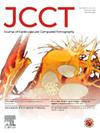Impact of an institutional process change adopting end-systolic coronary CTA acquisition and automated dose selection on patient throughput and image quality
IF 5.5
2区 医学
Q1 CARDIAC & CARDIOVASCULAR SYSTEMS
引用次数: 0
Abstract
Introduction
Guidelines recommend prospective ECG-triggered mid-diastolic coronary computed tomographic angiography (CCTA) acquisition after achieving optimal heart rate (HR) control in order to optimize scan image quality. With dual-source CCTA, prospective end-systolic acquisition has been shown to be less prone to motion artifacts at higher heart rates and may improve scan and CT laboratory efficiency by allowing CCTA without routine pre-scan beta-blocker (BB) administration.
Methods
We implemented an institutional process change in CCTA performance effective January 2023, comprising a transition from prospective ECG-triggered mid-diastolic acquisitions individually supervised by a physician at the scanner to an algorithmic approach predominately utilizing prospective end-systolic acquisition (200–400 ms after R peak), employing an automated dose selection algorithm, without BB administration. All scans were performed on a third-generation 192-slice dual-source scanner. We reviewed 300 consecutive CCTAs done pre- and post-process change in Jan 2022 (phase 0), Jan 2023 (phase 1), and in May 2023 (phase 2) after implementation of a process improvement involving more selective utilization of automated tube potential/current algorithms (CARE kV) to optimize image quality. Coronary segmental image quality was assessed by two experienced CCTA readers by consensus using an 18-segment SCCT model on a 5-point Likert scale (1 = non-interpretable; 2 = poor; 3 = acceptable; 4 = good; 5 = excellent). Measures of radiation dose, medication administration, and time required for patient scanning were compared. Logistic regression was used to determine factors associated with patient-level reduction in image quality (IQ) and with repeat scans.
Results
Post-process change, there was a significant reduction in the median overall patient appointment [phase 0: 95 (75–125) min vs. phase 1: 68 (52–88) min and phase 2: 72 (59–90) min; P < 0.001] and scan times [phase 0: 13 (10–16) min vs. phase 1: 8 (6–13) min and phase 2: 9 (7–13) min; P < 0.001]. Median IQ score in both post-process change phases was 4 (4–5) compared to a median score of 5 (4–5) pre-process change (P for comparison <0.001). The majority of segments post-process change had “good” IQ (Phase 1 segmental IQ scores: 5 = 36.7 %, 4 = 46.8 %, 3 = 13 %, 2 = 2.6 %, 1 = 0.9 %; Phase 2 segmental IQ scores: 5 = 26 %, 4 = 49.7 %, 3 = 16.3 %, 2 = 6.1 %, 1 = 1.9 %), whereas pre-process change, the majority of segments had “excellent” IQ (Phase 0 segmental IQ scores: 5 = 56 %, 4 = 34.3 %, 3 = 7.5 %, 2 = 1.8 %, 1 = 0.4 %) There was no significant increase in non-interpretable scans at the patient level. The 22 % re-scan rate in phase 1 (vs. 6 % in phase 0, P = .002) improved to 15 % in phase 2. While patient related factors of body mass index [adjusted OR obese 2.64, 95 % CI 1.12–6.51, P = 0.03; aOR morbidly obese 6.94, 95 % CI 2.21–23.52, P = 0.001] and average HR [aOR (per 10 bpm increase) 1.51, 95 % CI 1.21–1.9, P < 0.001] were associated with the scoring of any segment as ≤ 3 at the patient level in a fully adjusted model, the improved phase 2 of the process change was not [aOR 1.61, 95 % CI 0.78–3.32].
Conclusion
Implementation of an institutional process change utilizing prospective ECG-triggered dual-source end-systolic acquisition avoided the use of beta-blockers, significantly reduced patient appointment and scan times with acceptable diagnostic performance.
采用收缩末期冠状动脉 CTA 采集和自动剂量选择的机构流程变革对患者吞吐量和图像质量的影响。
导言:指南建议在达到最佳心率(HR)控制后进行前瞻性心电图触发的舒张中期冠状动脉计算机断层扫描(CCTA)采集,以优化扫描图像质量。在双源 CCTA 中,前瞻性收缩末期采集已被证明在心率较高时不易出现运动伪影,而且可以在扫描前不常规使用β-受体阻滞剂(BB),从而提高扫描和 CT 实验室的效率:我们从 2023 年 1 月起对 CCTA 性能实施了机构流程改革,包括从由医生在扫描仪旁单独监督的前瞻性心电图触发舒张中期采集过渡到主要利用前瞻性收缩末期采集(R 峰后 200-400 毫秒)的算法方法,该方法采用自动剂量选择算法,无需使用β-受体阻滞剂。所有扫描均在第三代 192 片双源扫描仪上进行。我们对 2022 年 1 月(第 0 阶段)、2023 年 1 月(第 1 阶段)和 2023 年 5 月(第 2 阶段)连续进行的 300 例 CCTAs 进行了流程变更前后的审查,流程变更后,我们将更有选择性地使用自动管电位/电流算法(CARE kV)来优化图像质量。冠状动脉节段图像质量由两名经验丰富的 CCTA 阅读者使用 18 节段 SCCT 模型以 5 点李克特量表(1 = 无法解读;2 = 差;3 = 可接受;4 = 好;5 = 极佳)一致评估。对辐射剂量、用药量和患者扫描所需时间进行了比较。采用逻辑回归法确定与患者图像质量(IQ)下降和重复扫描相关的因素:结果:流程改变后,患者预约时间的中位数明显减少[第 0 阶段:95 (75-125) 分钟;第 1 阶段:68 (52-88) 分钟;第 2 阶段:72 (59-90) 分钟;P 结论:流程改变后,患者预约时间的中位数明显减少:利用前瞻性心电图触发双源收缩末期采集实施机构流程变革,避免了β-受体阻滞剂的使用,显著缩短了患者预约时间和扫描时间,且诊断效果可接受。
本文章由计算机程序翻译,如有差异,请以英文原文为准。
求助全文
约1分钟内获得全文
求助全文
来源期刊

Journal of Cardiovascular Computed Tomography
CARDIAC & CARDIOVASCULAR SYSTEMS-RADIOLOGY, NUCLEAR MEDICINE & MEDICAL IMAGING
CiteScore
7.50
自引率
14.80%
发文量
212
审稿时长
40 days
期刊介绍:
The Journal of Cardiovascular Computed Tomography is a unique peer-review journal that integrates the entire international cardiovascular CT community including cardiologist and radiologists, from basic to clinical academic researchers, to private practitioners, engineers, allied professionals, industry, and trainees, all of whom are vital and interdependent members of our cardiovascular imaging community across the world. The goal of the journal is to advance the field of cardiovascular CT as the leading cardiovascular CT journal, attracting seminal work in the field with rapid and timely dissemination in electronic and print media.
 求助内容:
求助内容: 应助结果提醒方式:
应助结果提醒方式:


